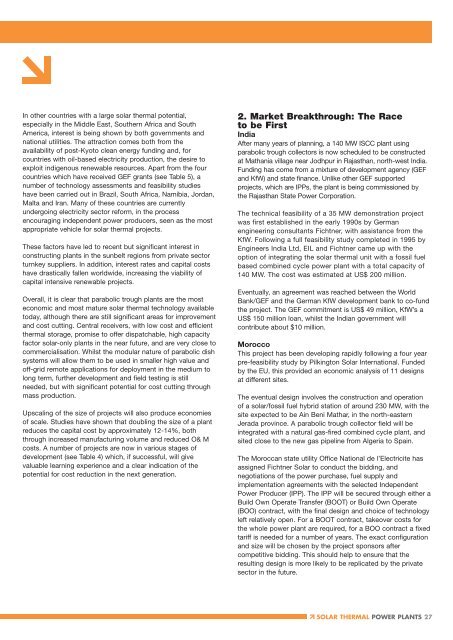solar thermal power - Greenpeace
solar thermal power - Greenpeace
solar thermal power - Greenpeace
Create successful ePaper yourself
Turn your PDF publications into a flip-book with our unique Google optimized e-Paper software.
In other countries with a large <strong>solar</strong> <strong>thermal</strong> potential,<br />
especially in the Middle East, Southern Africa and South<br />
America, interest is being shown by both governments and<br />
national utilities. The attraction comes both from the<br />
availability of post-Kyoto clean energy funding and, for<br />
countries with oil-based electricity production, the desire to<br />
exploit indigenous renewable resources. Apart from the four<br />
countries which have received GEF grants (see Table 5), a<br />
number of technology assessments and feasibility studies<br />
have been carried out in Brazil, South Africa, Namibia, Jordan,<br />
Malta and Iran. Many of these countries are currently<br />
undergoing electricity sector reform, in the process<br />
encouraging independent <strong>power</strong> producers, seen as the most<br />
appropriate vehicle for <strong>solar</strong> <strong>thermal</strong> projects.<br />
These factors have led to recent but significant interest in<br />
constructing plants in the sunbelt regions from private sector<br />
turnkey suppliers. In addition, interest rates and capital costs<br />
have drastically fallen worldwide, increasing the viability of<br />
capital intensive renewable projects.<br />
Overall, it is clear that parabolic trough plants are the most<br />
economic and most mature <strong>solar</strong> <strong>thermal</strong> technology available<br />
today, although there are still significant areas for improvement<br />
and cost cutting. Central receivers, with low cost and efficient<br />
<strong>thermal</strong> storage, promise to offer dispatchable, high capacity<br />
factor <strong>solar</strong>-only plants in the near future, and are very close to<br />
commercialisation. Whilst the modular nature of parabolic dish<br />
systems will allow them to be used in smaller high value and<br />
off-grid remote applications for deployment in the medium to<br />
long term, further development and field testing is still<br />
needed, but with significant potential for cost cutting through<br />
mass production.<br />
Upscaling of the size of projects will also produce economies<br />
of scale. Studies have shown that doubling the size of a plant<br />
reduces the capital cost by approximately 12-14%, both<br />
through increased manufacturing volume and reduced O& M<br />
costs. A number of projects are now in various stages of<br />
development (see Table 4) which, if successful, will give<br />
valuable learning experience and a clear indication of the<br />
potential for cost reduction in the next generation.<br />
2. Market Breakthrough: The Race<br />
to be First<br />
India<br />
After many years of planning, a 140 MW ISCC plant using<br />
parabolic trough collectors is now scheduled to be constructed<br />
at Mathania village near Jodhpur in Rajasthan, north-west India.<br />
Funding has come from a mixture of development agency (GEF<br />
and KfW) and state finance. Unlike other GEF supported<br />
projects, which are IPPs, the plant is being commissioned by<br />
the Rajasthan State Power Corporation.<br />
The technical feasibility of a 35 MW demonstration project<br />
was first established in the early 1990s by German<br />
engineering consultants Fichtner, with assistance from the<br />
KfW. Following a full feasibility study completed in 1995 by<br />
Engineers India Ltd, EIL and Fichtner came up with the<br />
option of integrating the <strong>solar</strong> <strong>thermal</strong> unit with a fossil fuel<br />
based combined cycle <strong>power</strong> plant with a total capacity of<br />
140 MW. The cost was estimated at US$ 200 million.<br />
Eventually, an agreement was reached between the World<br />
Bank/GEF and the German KfW development bank to co-fund<br />
the project. The GEF commitment is US$ 49 million, KfW’s a<br />
US$ 150 million loan, whilst the Indian government will<br />
contribute about $10 million.<br />
Morocco<br />
This project has been developing rapidly following a four year<br />
pre-feasibility study by Pilkington Solar International. Funded<br />
by the EU, this provided an economic analysis of 11 designs<br />
at different sites.<br />
The eventual design involves the construction and operation<br />
of a <strong>solar</strong>/fossil fuel hybrid station of around 230 MW, with the<br />
site expected to be Ain Beni Mathar, in the north-eastern<br />
Jerada province. A parabolic trough collector field will be<br />
integrated with a natural gas-fired combined cycle plant, and<br />
sited close to the new gas pipeline from Algeria to Spain.<br />
The Moroccan state utility Office National de l’Electricite has<br />
assigned Fichtner Solar to conduct the bidding, and<br />
negotiations of the <strong>power</strong> purchase, fuel supply and<br />
implementation agreements with the selected Independent<br />
Power Producer (IPP). The IPP will be secured through either a<br />
Build Own Operate Transfer (BOOT) or Build Own Operate<br />
(BOO) contract, with the final design and choice of technology<br />
left relatively open. For a BOOT contract, takeover costs for<br />
the whole <strong>power</strong> plant are required, for a BOO contract a fixed<br />
tariff is needed for a number of years. The exact configuration<br />
and size will be chosen by the project sponsors after<br />
competitive bidding. This should help to ensure that the<br />
resulting design is more likely to be replicated by the private<br />
sector in the future.<br />
SOLAR THERMAL POWER PLANTS 27

















